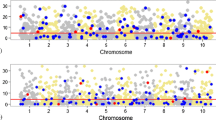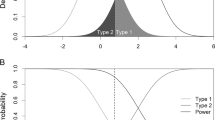Abstract
Quantitative-trait association studies have been widely used in search for genetic loci for complex traits in recent years. Yet, fiscal constraints still prohibit many on-going research projects from recruiting a large number of individuals for genotyping to reach a desired level of statistical power. Accordingly, in this article, we describe a novel sib pair sampling strategy for genotyping in QTL association studies. With the use of phenotypic scores (and IBD allele-sharing probabilities if available), the genetic effect of a biallelic additive trait locus can be properly modelled within the maximum-likelihood variance components framework proposed by Fulker et al. (Am J Hum Genet 64(1):259–267, 1999) and sib pairs can be rank-ordered by use of informativeness indices. The performance of our method was investigated using simulation. The power of our approach was shown to be higher when compared with other phenotypic selection schemes. An R-script implementing all the selection approaches (including the traditional phenotype-based ones) used in the simulation is available at http://statgen.hku.hk/jshkwan.


Similar content being viewed by others
References
Abecasis GR, Cookson WO, Cardon LR (2001) The power to detect linkage disequilibrium with quantitative traits in selected samples. Am J Hum Genet 68(6):1463–1474
Abecasis GR, Cherny SS, Cookson WO, Cardon LR (2002) Merlin—rapid analysis of dense genetic maps using sparse gene flow trees. Nat Genet 30(1):97–101
Allison DB, Heo M, Schork NJ, Wong SL, Elston RC (1998) Extreme selection strategies in gene mapping studies of oligogenic quantitative traits do not always increase power. Hum Hered 48(2):97–107
Cardon LR, Bell JI (2001) Association study designs for complex diseases. Nat Rev Genet 2(2):91–99
Carey G, Williamson J (1991) Linkage analysis of quantitative traits: increased power by using selected samples. Am J Hum Genet 49(4):786–796
Eaves L, Meyer J (1994) Locating human quantitative trait loci: guidelines for the selection of sibling pairs for genotyping. Behav Genet 24(5):443–455
Falconer DS, Mackay TFC (1996) Introduction to quantitative genetics. Longman, Harlow
Fingerlin TE, Boehnke M, Abecasis GR (2004) Increasing the power and efficiency of disease-marker case-control association studies through use of allele-sharing information. Am J Hum Genet 74(3):432–443
Fulker DW, Cherny SS, Sham PC, Hewitt JK (1999) Combined linkage and association sib-pair analysis for quantitative traits. Am J Hum Genet 64(1):259–267
Purcell S, Cherny SS, Hewitt JK, Sham PC (2001) Optimal sibship selection for genotyping in quantitative trait locus linkage analysis. Hum Hered 52(1):1–13
Purcell S, Neale B, Todd-Brown K, Thomas L, Ferreira MA, Bender D, Maller J, Sklar P, de Bakker PI, Daly MJ et al (2007) PLINK: a tool set for whole-genome association and population-based linkage analyses. Am J Hum Genet 81(3):559–575
Risch NJ (2000) Searching for genetic determinants in the new millennium. Nature 405(6788):847–856
Risch N, Merikangas K (1996) The future of genetic studies of complex human diseases. Science 273(5281):1516–1517
Risch N, Teng J (1998) The relative power of family-based and case-control designs for linkage disequilibrium studies of complex human diseases I. DNA pooling. Genome Res 8(12):1273–1288
Risch N, Zhang H (1995) Extreme discordant sib pairs for mapping quantitative trait loci in humans. Science 268(5217):1584–1589
Sham PC, Purcell S (2001) Equivalence between Haseman–Elston and variance-components linkage analyses for sib pairs. Am J Hum Genet 68(6):1527–1532
Acknowledgments
This work was supported by grants HKU 7674/07M (A.W.C.K) and HKU 7669/06M (P.C.S) from the Research Grants Council of Hong Kong and grant EY-12562 (S.S.C, P.C.S) from the National Institutes of Health (USA).
Author information
Authors and Affiliations
Corresponding author
Additional information
Edited by David Allison.
Appendix
Appendix
For an additive locus with a trait-increasing allele, A 1, of frequency p and the other allele, A 2, of frequency 1 − p, the additive effects (a) of genotypes A 1 A 1, A 1 A 2 and A 2 A 2, can be coded as 1, 0.5 and 0, respectively. The expected additive effect of the locus in a random mating and large population, E(a), is therefore, 1 × p 2 + 0.5 × 2p(1 − p) + 0 × (1 − p)2 = p, and the variance,
Let Q = α + βa, where α and β are constants such that E(Q) = 0 and Var(Q) = 1, so
By solving the equations, one gets \( \alpha = { - p/\sqrt {p(1 - p)/2} } \) and \( \beta = {1/\sqrt {p(1 - p)/2} } \), respectively.
Rights and permissions
About this article
Cite this article
Kwan, J.S.H., Cherny, S.S., Kung, A.W.C. et al. Novel Sib Pair Selection Strategy Increases Power in Quantitative Association Analysis. Behav Genet 39, 571–579 (2009). https://doi.org/10.1007/s10519-009-9284-x
Received:
Accepted:
Published:
Issue Date:
DOI: https://doi.org/10.1007/s10519-009-9284-x




